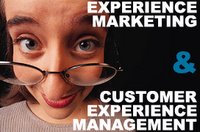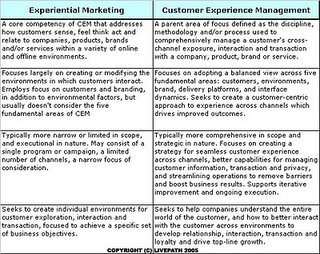Customer Experience Management
vs.Experiential Marketing (Part II)
 Continuing the dialog on defining Customer Experience Management (CEM)...
Continuing the dialog on defining Customer Experience Management (CEM)...Many individuals equate CEM with Experiential Marketing. However, the term "experiential marketing" has become perceptually aligned with marketing execution in recent years. This is because it largely focuses on developing highly visible, stimulating, interactive and sensory-engaging environments in which products and services are showcased. As such, experiential marketing is an important component of CEM, but it isn’t the “whole enchilada” (Ole').
The environments experiential marketers focus on are diverse. You'll often find a large emphasis on shaping the "walk-in" experience of brick and mortar environments. This is done with the goal of creating more positive, intuitive, memorable, engaging and pleasing environments which better engage, entertain and support customers. Some examples of this include:
Museums and galleries. Because they focus on creating a sensory experience, museums and galleries like the Guggenheim, the Smithsonian, and the San Francisco MOMA have always had a high level of focus on how to create the proper experiential environment for visitors and have therefore been proactive in the application of new technology to enhance experience and both preserve works of art for future visitors.Experiential Marketing carries with it as strong association with event-driven marketing. In the past, this has been primarily associated with trade shows, technology showcases and industry conferences. Howver, today, event-driven marketing tactics are becoming increasingly popular in non-traditional venues, such as:
Stores. Retail outlets that sell goods are placing increasing emphasis on developing more experiential environments. Visit REI and spend some time on the climbing walls available for public use. Walk in to a Build-A-Bear Workshop and create a custom toy, complete with a voice chip, for a friend or loved one. Other, more obvious experiential retail environments include Apple Stores, Niketown, the American Girl stores. More subtle examples include Sephora, Anthropologie, Origins and Libby Loo.
Restaurants. It's not just about food anymore. Restaurants are getting into the game, as well. Almost all of us are familiar with the time-tested experience offered by Chuck E Cheese. Some more modern examples of the Rainforest Cafe and Planet Hollywood. You don't have to be big to be experiential. My five year old niece's favorite restaurant is Sushi Takahashi, because of the circular sushi bar and the circling model train which delivers your order. My brother and I like it because the sushi is great, and cheap.
Non-traditional Environments, and is alive and well in several popular grocery chains, such as Wegman’s and Whole Foods. We’re also seeing forays into experiential marketing within the financial services (e.g. ING Cafés), health care (e.g. Minute Clinic) and other industries.
Microsoft's somewhat recent and highly successful multi-venue Tablet PC promotional event. Born out of a partnership between Microsoft and the Jack Morton agency the event resulted in 125,000 product demonstrations in high-traffic airport terminals in major hub airports across the country.As marketing becomes increasingly experiential in nature, the lines of demarcation between event-driven marketing and other promotions are becoming increasingly cloudy. For example:
Another example was featured recently in a recent CMO Magazine article on B2B experiential marketing. The article highlights IBM’s Merlin Center, an experiential environment created to effectively demonstrate the future of high technology banking to bank executives. The experience starts in a living-room like environment featuring warm biscotti and coffee. It gradually transitions into an experience that has been described as a "virtual themepark for banking executives."
Adrants recently gave a hat-tip to Lexus, which drew attention for strategically placed experiential displays positioned in Times Square and a several other key US locations. The displays, placed at sidewalk level in shop windows, featured a “holographic” animation of the IS in motion - zooming, spinning, turning and driving within the store window space. Interactive kiosks allowed visitors to control the display features, such as the color of the car. The displays drew substantial attention and shut down street corners successfully as onlookers jammed busy sidewalks.Experiential marketing also applies heavily to the online world, where the constant drive to innovate and improve customer experience and dynamic qualities are ever present. Product searching, personal recommendations, reviews, rating tools, list sorting/filtering and wish lists become common features of top retail and/or promotional sites.
Experiential marketing promotions were also featured in recent episodes of the hit TV show “The Apprentice.” In several shows, the teams were assigned the task of creating innovative marketing campaigns for Dick’s Sporting Goods and Tide, as well as innovative product displays for Best Buy’s video release of Star Wars III.
Today, companies strive to press the envelope of traditional interactivity further, to improve site and application usability. In addition to utilizing rich media, flash, DHTML, Java and Ajax to bring new, more engaging and effective sites to bear, an increasing number of companies are making good use of other techniques. Viral microsites, gaming, downloads and eCards are being used to help encourage site interaction and visitation. Blogs and podcasting are adding a whole new dimension to site interactivity and content. Product customization, enhanced products and services are an emerging trend.
Nike allows customers to create and customize their own athletic gear at NikeID.com.It occurs to me that I'm preachin' to the choir now. Many of you are highly familiar of the tenants of experiential marketing - and I haven't even addressed how the really great experiential marketers pay so much detail to interaction, they work to refine person-to-person interaction within these environments (e.g. the W Hotel), or engineer product displays to boost the efficacy of merchandising - among other things. However, in the interest of length, let's move on to discuss how experiential marketing relates to CEM.
Online stores like Lands End and The Gap’s "Watch Me Change" viral site allow customers to create customized avatars, based on the peronal height, weight and body style attributes. The avatars can “try on” selected clothing for the customer and allow style and fit comparisons. In the case of The Gap, you can also get them to perform an entertaining strip tease for you, and pass it along to a friend.
In addition to hosting an online car configurator, Mini Cooper has an interactive site somewhere (sorry, couldn't FIND the flash application while writing this article!) showcasing a wide number of customized roof wraps customers can puchase for their cars. The artwork includes the british flag, sci-fi scenes, the Mona Lisa and much more.
The Converse Gallery offers independent film makers the ability to submit 20 second short films, dedicated to the Converse brand. Many of the high quality "shorts" are now serving as part of Converse's national advertising campaign.
Unfortunately, many executives are being seduced by the flashier side of experiential marketing and can mistake it for CEM in its pure form. A cadre of agencies now purport to have expertise in experiential marketing and readily capitalize on opportunities presented by market shifts, retail expansion and new technologies. Typically, however, such agencies execute work within a relatively narrow scope - compared to full-blown CEM project work.
Confusion between experiential marketing and CEM often forces attention away from the real value and tangible benefits of CEM initiatives. The differentiation the two can be succinctly described as follows:

In closing, I'm not a huge fan of buzz words or hype. It's a simple truth that everything we do as marketers is experiential at some level - from the brand assets we create, to the packaging, collateral, IVR scripts we write, or the stores and web sites we manage. We have complete control over how "experiential", engaging or stimulating we are, and how perfunctory the interactions we design become. At times, perfunctory is better... and at other times, engaging, stimulating and sensory-involving is better.
Whatever the case, the companies that are faithful in the "little things" will be granted much more. Each little customer interaction is a highly valuable part of a larger set of interactions. The outcomes of customer interactions shape brand perception. Customer interactions should therefore be strategically designed and executed to work together to collectively lead the customer in an appropriate (and positive) direction that compliments personal goals and business objectives. This is the core focus of CEM.
The true leaders in customer experience understand these principles. They are adamant about creating experiences within channels - and across channels - that are intuitive, consistent, engaging, cohesive, safe, relevant, seamless, memorable and satisfying for customers. Experience leaders never get caught up in flash over substance, but leverage experiential marketing as an effective tool to gain exposure, attention and customer mindshare. They focus a great deal of energy on becoming increasingly proficient in the principles of Customer Experience Management.
Subscribe to:
Post Comments (Atom)
FAVORITES
- On Trust & Influence
- Don't be Social Media Sharkbait
- The Social Media Engagement Continuum
- 10 Tips for Twitter Unmarketing
- Five Experience Funamentals
- Experience & Branding: The Three Word Rule
- Get Some Experience Healing!
- Discovering Customer Experience Pitfalls
- Not My Job: The CX Enemy
- Shoe Carnival: Watch Out for Carnies!
- Bathroom Usability
RECENT COMMENTS
SEARCH
LEIGH DURST

I’m Leigh Durst, a 20 year veteran in business, operations, customer strategy, ecommerce, digital & social media and marketing. Simply put, I’m a strategist that helps companies (start-up to blue chip) achieve business shift, create more compelling online and offline experiences. I also write, speak and teach about experience design and next-generation business. I’m a futurist, visionary, strategist, doer and connector with a passion for people and helping others. When I’m not on the road, you’ll find me in the San Francisco bay area, working, beaching it and hanging out with my family and dog.
Labels
Best Practices
CX
Community
Content
Copy writing
Customer Experience Leaders
Customer Relationship Management
Defining Customer Experience Management
Ethics
Group Think
Harassment
Innovation
Plagiarism
Plurk
RESOURCES
Social Media
Social Media Expert
Twitter
UX
Web 2.0
Web Strategy
advertising
air travel
bank experience
bathrooms
branding
brick and mortar retail
charlene li
cottonelle
customer centricity
customer experience
customer experience files
customer experience management
customer experience pitfalls
customer experience; innovation;
customer research
economy
experience best practices
experience file
experience pitfalls
good customer experience
infrastructure
life
marketing
marketng
motherhood
old navy
personal
privacy
reinvention
restaurant experience
retail experience
security
social networking
starbucks
stuck
target
toilet paper
trust agents
trust continuum
usability best practices
user experience
user experience
word-of-mouth



5 comments:
Most insightful. Thank you.
jack mardack
profitLABINC.com
Many thanks! Comprehensive approach to compare between the 2. Just in time for my coming Monday paper. Appreciate the information!
Cheers
BeL™ †
Many thanks for the comprehensive approach to compare the 2. Just in time as was looking for some material on experiential marketing for my coming Monday paper. Greatly appreciate it!
Cheers
BeL™ †
Great article, this will be an awesome resource for my experiential marketing paper coming up. Thanks for doing the hard work for me!
First of all, I would like to say about the above content is it is very well comparison between two effective important factors of marketing. It is well explained note too.
Post a Comment